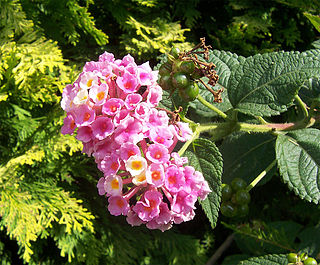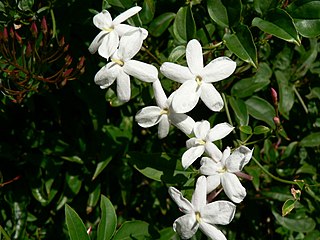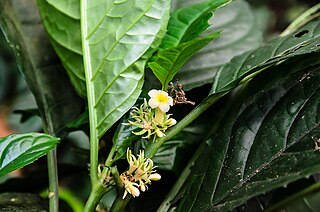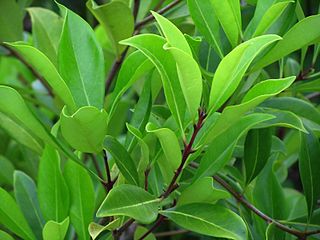
Syringa is a genus of 12 currently recognized species of flowering woody plants in the olive family or Oleaceae called lilacs. These lilacs are native to woodland and scrub from southeastern Europe to eastern Asia, and widely and commonly cultivated in temperate areas elsewhere.

Oleaceae, also known as the olive family or sometimes the lilac family, is a taxonomic family of flowering shrubs, trees, and a few lianas in the order Lamiales. It presently comprises 28 genera, one of which is recently extinct. The extant genera include Cartrema, which was resurrected in 2012. The number of species in the Oleaceae is variously estimated in a wide range around 700. The flowers are often numerous and highly odoriferous. The family has a subcosmopolitan distribution, ranging from the subarctic to the southernmost parts of Africa, Australia, and South America. Notable members include olive, ash, jasmine, and several popular ornamental plants including privet, forsythia, fringetrees, and lilac.

Jasmine is a genus of shrubs and vines in the olive family of Oleaceae. It contains around 200 species native to tropical and warm temperate regions of Eurasia, Africa, and Oceania. Jasmines are widely cultivated for the characteristic fragrance of their flowers. Additionally a number of unrelated species of plants or flowers contain the word "jasmine" in their common names.

The Verbenaceae, the verbena family or vervain family, is a family of mainly tropical flowering plants. It contains trees, shrubs, and herbs notable for heads, spikes, or clusters of small flowers, many of which have an aromatic smell.

Fraxinus albicans, commonly called the Texas ash, is a species of tree in the olive family (Oleaceae). It is native to North America, where it is found from eastern Texas and southern Oklahoma in the United States, to the state of Durango in Mexico. Its natural habitat is in dry, rocky slopes, often over limestone.

Osmanthus is a genus of about 30 species of flowering plants in the family Oleaceae. Most of the species are native to eastern Asia with a few species from the Caucasus, New Caledonia, and Sumatra. Osmanthus has been known in China since ancient times with the earliest writings coming from the Warring States period; the book Sea and Mountain. South Mountain states: "Zhaoyao Mountain had a lot of Osmanthus".

Cartrema americana, commonly called American olive, wild olive, or devilwood, is an evergreen shrub or small tree native to southeastern North America, in the United States from Virginia to Texas, and in Mexico from Nuevo León south to Oaxaca and Veracruz.

Nyctanthes is a genus of flowering plants in the family Oleaceae, native to southeastern Asia. It is currently accepted as containing two species; other species previously included in this genus have been transferred to other genera, most of them to Jasminum.
The Melchior system, "a reference in all taxonomic courses", is a classification system detailing the taxonomic system of the Angiospermae according to A. Engler's Syllabus der Pflanzenfamilien (1964), also known as "modified or updated" Engler system.
Priogymnanthus is a genus of three species of flowering plants in the family Oleaceae native to tropical South America, in Bolivia, Brazil, Colombia, Ecuador, Argentina and Paraguay.
Native olive is a common name for several plants and may refer to:

Jasmineae is a tribe of flowering plants in the olive family, Oleaceae.

The Carlemanniaceae are a tropical East Asian and Southeast Asian family of subshrub to herbaceous perennial flowering plants with 2 genera. Older systems of plant taxonomy place the two genera, Carlemannia, and Silvianthus within the Caprifoliaceae or the Rubiaceae. The Angiosperm Phylogeny Group classification of 2003 places the group in the Lamiales, as a plant family more closely related to the Oleaceae than to the Caprifoliaceae.

Oleeae is a tribe of flowering plants in the olive family, Oleaceae.

Forsythieae is a tribe of flowering plants in the olive family, Oleaceae.
Emil Friedrich Knoblauch was a German botanist.
Hesperelaea is a plant genus with only one species, probably now extinct. Hesperelaea palmeri was found only on Guadalupe Island, a small island in the Pacific Ocean, part of the Mexican state of Baja California, about 400 km (250 mi) southwest of Ensenada. The last collection of the plant on the island was in 1875, so the species and the genus must now be presumed extinct. An intensive search for the plant in 2000 was unsuccessful.

Cartrema is a genus of a few species of flowering plants in the family Oleaceae, native to southeastern Asia, southern China, and North America, formerly treated as section Leiolea of Osmanthus. Species of Cartrema may be distinguished from those of Osmanthus by the paniculate inflorescences of the former.
Peter Shaw Green was an English botanist.
Alexander von Lingelsheim was a German botanist and pharmacist.













